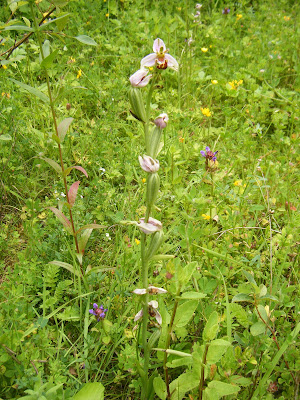 |
| Bee Orchid, Ophrys apifera |
Probably the most beautiful wildflower growing in Ireland is the Bee Orchid (Ophrys apifera). Its devastatingly ornate flowers are shaped, as the common name suggests, just like a bee. Such morphology is a form of mimicry used to facilitate pollination. No pollen nectar or pollen is offered by O. apifera to potential pollinators: instead male bees are attracted by odours that act on their sexual instincts (1). Patrolling males that are attracted to a flower become sexually excited and alight on the labellum. The male is then guided in a copulation attempt by a variety of tactile clues such as the firmness of the labellum. Movements during such copulation attempts brings about pollination. Other species of the Ophrys genus have similar chemical, visual and tactile stimuli which are sufficiently different from each other to act as pollination barriers between taxa. However, in Ireland (and Britain) there is an absence of a sufficent pollinator O. apifera are self-fertilised here (2).
 |
| Bee Orchid, Ophrys apifera |
O. apifera is a perennial of grassy, calcareous ground, and is especially prevalent on recently disturbed ground (3, 4). Numbers in Ireland have been in decline since the beginning of the twentieth century due to a combination of altered agricultural practices and habitat loss (2). In County Cork, most sites for O. apifera are located on the west and east coasts and, according to Tony O'Mahony's Wildflowers of Cork City and County (2) no sites in Mid Cork are in existence. It was therefore with some excitement that I discovered c. 10 plants in a 2 m2 area of ground in an abandoned, flooded quarry just outside Shanbally some 19 km from Cork city. The disturbed nature of the quarry and the calcareous parent material provide the perfect habitat for this enigmatic flower.
 |
| Bee Orchid, Ophrys apifera |
References:
- Karin and Karlson, 1990. Phytochemistry 29 pp. 1359-1387
- O'Mahony, 2009. Wildflowers of Cork City and County pp. 302-303
- Phillips, 1977. Wild Flowers of Britain p. 94
- Gardiner and Vaughan, 2009. Conservation Evidence 6 pp. 39-41
No comments:
Post a Comment